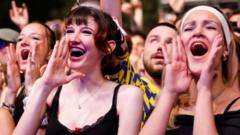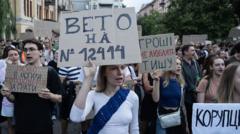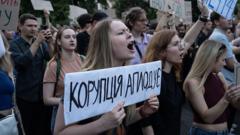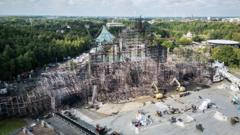The renowned music festival, rooted in pro-democracy activism, has historically gathered massive crowds and positioned Serbia as a vibrant cultural hub.
Exit Festival Withdraws from Serbia Amidst Political Pressures and Student Support

Exit Festival Withdraws from Serbia Amidst Political Pressures and Student Support
Exit Festival blames government funding cuts and state pressure for its withdrawal from Serbia, marking a significant cultural shift.
The Exit festival, one of Europe’s most considerable music events, is set to exit Serbia after its 25th anniversary, citing "undemocratic pressures" from the government as a significant reason. Organisers revealed that support for ongoing anti-corruption student protests led to the withdrawal of essential governmental funding and sponsorships, which they claim were influenced by state pressure. While provincial officials have refuted these allegations, stating financial constraints as the reason for their inability to support the festival, Exit's founder, Dusan Kovacevic, offered unwavering support for the students, declaring the financial toll as a small price to pay for freedom.
Known for taking place at the historic Petrovaradin Fortress in Novi Sad, Exit Festival drew in 200,000 visitors last year, cementing its status as a pivotal cultural event in Serbia. The festival has a legacy tied to Serbia’s fight for democracy, tracing back to protests against Slobodan Milosevic’s regime in 2000, and adopting various activist themes over the years like "Stop Human Trafficking" and "Loud and Queer".
The festival’s support of the student-led anti-corruption protests, ignited after a tragic incident at Novi Sad railway station last November that saw 16 lives lost, highlighted its commitment to social issues. In its efforts, Exit provided logistical support and joined protests alongside students, showcasing solidarity amidst a strained political landscape.
As the future of the festival remains uncertain, there are no current plans for its relocation to another country. The festival has garnered accolades over the years, even winning two European Festival of the Year awards. Daryl Fidelak, who manages a Belgrade-based record label, emphasized its profound impact on Serbia’s music scene, having altered the global perception of the country in terms of creativity and culture.
The Exit Festival has historically attracted renowned artists, with past line-ups featuring acclaimed acts like The White Stripes, Arctic Monkeys, and The Cure. Amid this turmoil, the situation serves as a reminder of the intersection between art, politics, and the significance of artistic expression in challenging times.
Known for taking place at the historic Petrovaradin Fortress in Novi Sad, Exit Festival drew in 200,000 visitors last year, cementing its status as a pivotal cultural event in Serbia. The festival has a legacy tied to Serbia’s fight for democracy, tracing back to protests against Slobodan Milosevic’s regime in 2000, and adopting various activist themes over the years like "Stop Human Trafficking" and "Loud and Queer".
The festival’s support of the student-led anti-corruption protests, ignited after a tragic incident at Novi Sad railway station last November that saw 16 lives lost, highlighted its commitment to social issues. In its efforts, Exit provided logistical support and joined protests alongside students, showcasing solidarity amidst a strained political landscape.
As the future of the festival remains uncertain, there are no current plans for its relocation to another country. The festival has garnered accolades over the years, even winning two European Festival of the Year awards. Daryl Fidelak, who manages a Belgrade-based record label, emphasized its profound impact on Serbia’s music scene, having altered the global perception of the country in terms of creativity and culture.
The Exit Festival has historically attracted renowned artists, with past line-ups featuring acclaimed acts like The White Stripes, Arctic Monkeys, and The Cure. Amid this turmoil, the situation serves as a reminder of the intersection between art, politics, and the significance of artistic expression in challenging times.


















